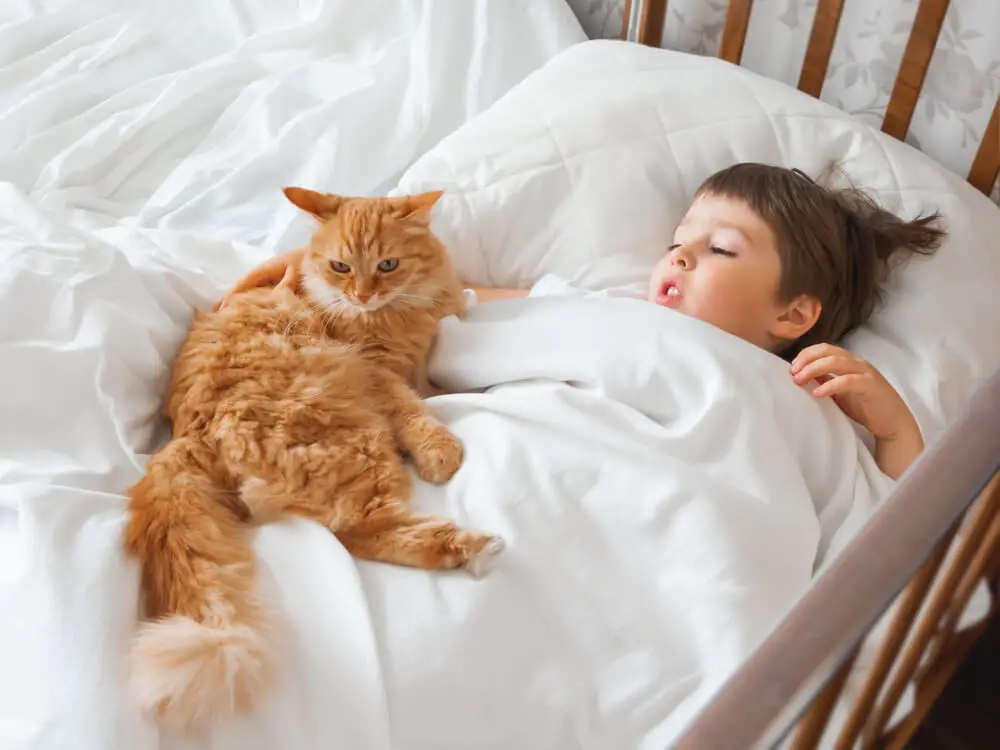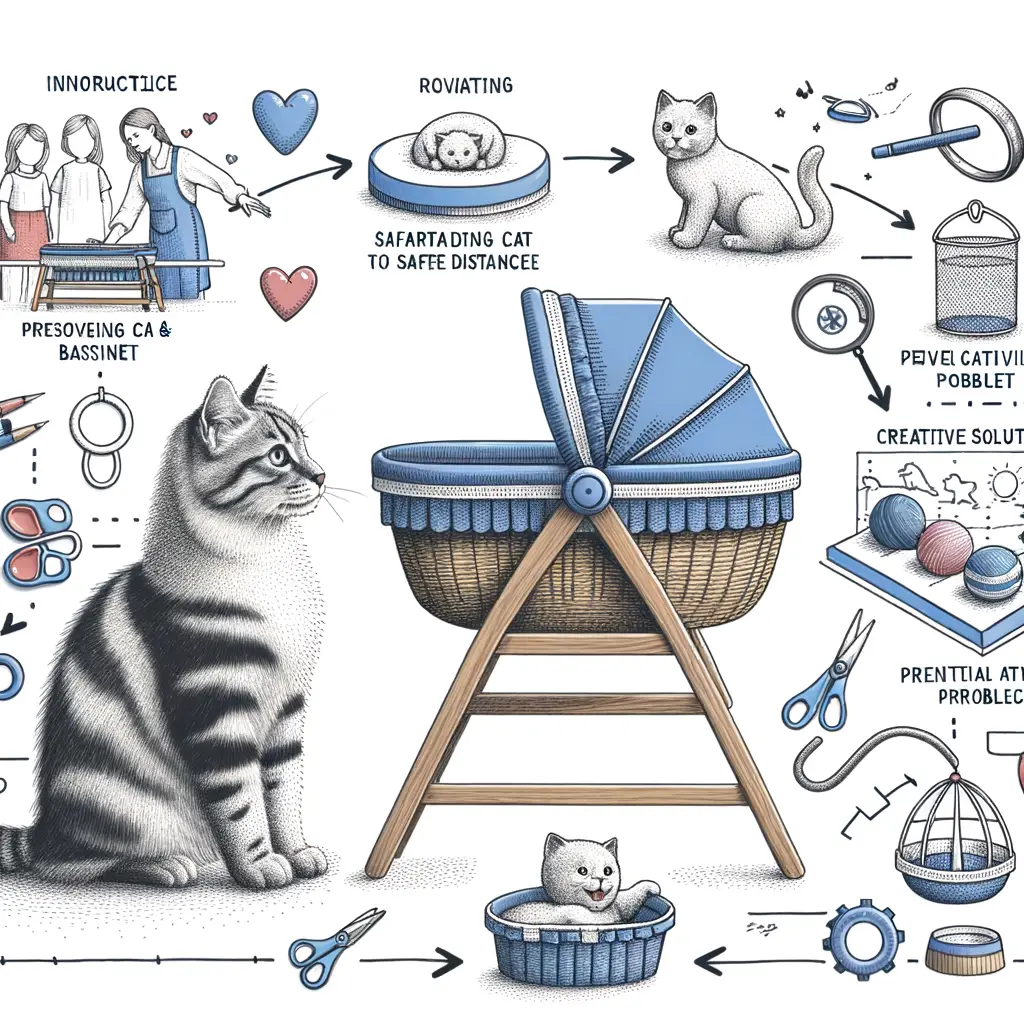Introduction: The Cat and Baby Bassinet Issue
As a new parent, you may find yourself facing a unique challenge: your furry feline friend’s fascination with your baby’s bassinet. This issue is more common than you might think, and it’s important to understand why it happens and how to address it.
Understanding the problem: Why cats are attracted to baby bassinets
Cats are naturally curious creatures. They are drawn to new objects in their environment, especially if they are soft, warm, and cozy – just like a baby’s bassinet. The smell of the baby can also attract them. It’s not that your cat wants to harm your baby, they are simply intrigued by this new addition to their territory. However, this curiosity can lead to potential risks, which is why it’s crucial to keep your cat out of the baby’s bassinet.
The importance of keeping your cat away from the baby’s bassinet
While your cat means no harm, their presence in the baby’s bassinet can pose health risks to your newborn. Cats can carry bacteria on their fur and paws, which can potentially cause infections. Additionally, there’s a risk of the cat accidentally smothering the baby, especially if they decide to snuggle up while the baby is in the bassinet. Therefore, it’s essential to establish boundaries and keep the baby’s sleeping area off-limits to your cat.
In the following sections, we will delve deeper into cat behavior around baby bassinets, discuss effective ways to keep your cat out of the bassinet, and provide solutions for cat-proofing your baby’s bed. Our goal is to help you ensure the safety of your baby while maintaining a harmonious relationship with your beloved pet.
Cat Behavior Around Baby Bassinet
Understanding your cat’s behavior around a baby bassinet is crucial to ensuring the safety and comfort of your newborn. Cats are naturally curious creatures, and the introduction of a new element in their environment, such as a baby bassinet, can trigger a variety of reactions.
Understanding Cat Behavior

Before we delve into specific behaviors around the bassinet, let’s first understand why cats behave the way they do.
Why cats are attracted to warm, cozy places like bassinets: Cats are creatures of comfort. They are drawn to warm, cozy places where they can relax and feel secure. A baby bassinet, with its soft bedding and warm environment, can be very appealing to a cat. This is not a sign of aggression or jealousy, but simply a cat’s natural instinct to seek comfort.
How cats perceive the scent of a new baby: Cats have a highly developed sense of smell. The scent of a new baby is unique and intriguing to them. This new scent in their environment can trigger their curiosity, leading them to investigate the source – the baby bassinet. It’s important to remember that this is not a sign of hostility, but a natural reaction to a new scent.
Understanding these behaviors can help you better manage your cat’s interactions with the baby bassinet. In the next section, we will discuss how to observe your cat’s behavior and recognize signs of potential issues.
Observing Your Cat’s Behavior
Understanding your cat’s behavior is crucial in ensuring the safety of your baby. This involves closely monitoring your cat’s interest in the bassinet and recognizing any signs of potential issues.
Monitoring your cat’s interest in the bassinet
It’s important to observe how your cat interacts with the baby’s bassinet. Cats are naturally curious creatures and may be drawn to the new addition in your home. If your cat frequently jumps into the bassinet or tries to sleep in it, this could be a sign that the cat might pose a risk to the baby.
Keep a close eye on your cat’s behavior around the bassinet, especially when the baby is in it. If the cat seems overly interested or aggressive, it may be necessary to take steps to keep the cat away from the bassinet.
Recognizing signs of potential issues
There are several signs that your cat may not be adjusting well to the new baby. These include excessive meowing, hissing, or growling at the baby or bassinet. The cat may also show signs of stress, such as changes in eating or sleeping patterns, or inappropriate elimination.
If you notice any of these signs, it’s important to address the issue immediately. This could involve consulting with a veterinarian or a professional cat behaviorist.
Remember, your cat’s behavior can be a key indicator of how well they are adjusting to the new changes in your home. By closely observing your cat’s behavior, you can ensure the safety of your baby and maintain a harmonious household.
Effective Ways to Keep Cat Out of Bassinet
In this section, we will explore some effective ways to keep your cat out of the baby’s bassinet. One of the most effective methods is to train your cat. Let’s delve into how you can do this.
Training Your Cat
Training your cat to stay away from the bassinet involves a two-step process: introducing the bassinet to your cat and using specific training techniques.
Introducing the bassinet to your cat:
Before the baby arrives, let your cat sniff and explore the bassinet. This allows your cat to get familiar with the new object. However, make sure to supervise this interaction to prevent the cat from jumping in. Once the cat loses interest, it’s less likely to see the bassinet as a new and exciting place to explore.
Training techniques to discourage your cat from entering the bassinet:
There are several techniques you can use to discourage your cat from entering the bassinet. One effective method is to use a deterrent, like a pet-safe spray, around the bassinet. Cats dislike certain smells, and this can keep them away. Another technique is to use a firm ‘no’ when your cat approaches the bassinet. Over time, your cat will associate the bassinet with the ‘no’ command and stay away. Remember, patience and consistency are key when training your cat.
Training your cat not to jump into the bassinet is a proactive approach to ensure your baby’s safety. It’s important to start this training early, so your cat has time to adjust to the new rules before the baby arrives. For more information about cat behavior, you can visit this Wikipedia page.
Creating a Cat-Free Zone
Creating a cat-free zone is another effective way to keep your cat out of the baby’s bassinet. This involves setting up physical barriers and using deterrents to keep your cat away. Let’s explore these two methods in detail.
Setting up Physical Barriers
Physical barriers can be an effective way to keep your cat out of certain areas. These can include baby gates, closed doors, or even specially designed pet barriers. It’s important to ensure that these barriers are secure and that your cat cannot easily jump over or squeeze through them.
For instance, you can place a baby gate at the entrance of the nursery. This will allow you to keep the door open for ventilation while preventing your cat from entering. Another option could be to use a net or mesh cover for the bassinet when it’s not in use. This will prevent your cat from jumping into it.
Using Deterrents to Keep Your Cat Away
Cats are sensitive to certain smells and textures, and you can use this to your advantage. There are various cat deterrents available on the market, such as sprays, mats, or even certain plants, that can discourage your cat from approaching the bassinet.
For example, cats typically dislike the smell of citrus. You can place orange or lemon peels near the bassinet, or use a safe, citrus-based spray. Another option is to use a scat mat, which is a mat with small plastic spikes. It’s uncomfortable for cats to step on, but it doesn’t harm them. Placing this mat around the bassinet can deter your cat from approaching.
Remember, it’s important to use these deterrents wisely and ensure they are safe for both your baby and your cat. Always consult with a vet or a pet behaviorist if you’re unsure.
In conclusion, creating a cat-free zone involves a combination of physical barriers and deterrents. By implementing these strategies, you can ensure that your baby’s bassinet remains a safe and cat-free space.
Cat-Proofing Your Bassinet

Ensuring the safety of your newborn baby is a top priority, especially when it comes to their sleeping space. If you have a cat in your home, it’s essential to cat-proof your bassinet to prevent any unwanted incidents. Here are some effective strategies you can employ:
Choosing the right bassinet design
Not all bassinets are created equal. Some designs are more cat-proof than others. For example, a bassinet with a high, solid wall can prevent a curious cat from jumping in. A bassinet with a canopy can also provide an extra layer of protection. Additionally, consider a bassinet with a sturdy base that won’t tip over if your cat decides to climb on it. Remember, the goal is to make the bassinet unappealing and inaccessible to your cat while ensuring it’s safe and comfortable for your baby.
Using covers and nets to protect the bassinet
Another effective way to cat-proof your bassinet is by using covers or nets. These can act as a physical barrier, preventing your cat from getting into the bassinet. Look for a breathable mesh cover that allows for air circulation while keeping your cat out. Make sure the cover or net is securely attached to the bassinet and cannot be easily removed by your cat. This method not only keeps your cat out but also protects your baby from other potential hazards like insects.
Remember, cat-proofing your bassinet is not about punishing your cat, but rather about creating a safe environment for your baby. It’s also important to continue giving your cat attention and love during this transition period to prevent any feelings of jealousy or neglect. With the right precautions, you can ensure that both your baby and your cat can coexist peacefully in your home.
Solutions for Keeping Cat Out of Baby’s Bed
One of the most effective ways to keep your cat out of your baby’s bed is to provide alternative sleeping arrangements. This method not only ensures your baby’s safety but also gives your cat its own comfortable space to rest.
Alternative Sleeping Arrangements
Creating a separate sleeping area for your cat and helping it adjust to the new environment can be a great solution. Here are some steps you can take:
Setting up a separate sleeping area for your cat: Consider investing in a comfortable cat bed or a cozy cat tree. Place it in a quiet, low-traffic area of your home where your cat can relax without being disturbed. Make sure it’s away from the baby’s room to discourage the cat from wandering into the baby’s bed. You can also add some of your cat’s favorite toys or a piece of your clothing to make the new sleeping area more appealing.
Introducing your cat to its new sleeping area: Cats are creatures of habit and may resist changes to their routine. Introduce the new sleeping area gradually. Start by encouraging your cat to explore the new bed during the day. You can use treats or toys to make the new area more enticing. Over time, your cat will start associating the new area with positive experiences and begin to use it for sleeping.
Remember, patience is key when introducing any changes to your cat’s routine. It might take some time for your cat to adjust to the new sleeping area, but with consistency and positive reinforcement, your cat will eventually start using its new bed, keeping it out of your baby’s bed.
Professional Help
There are times when the situation might seem out of control, and you may need to seek professional help. Let’s discuss when and how professionals can assist in managing cat and bassinet issues.
When to Seek Help from a Professional
It’s essential to understand when to seek professional help. If you’ve tried all possible solutions and your cat still insists on jumping into the baby’s bassinet, it might be time to consult a professional. This could be a veterinarian or a professional cat behaviorist. They have the expertise to understand your cat’s behavior and provide effective solutions. For instance, if your cat is showing signs of anxiety or aggression, it’s best to consult a professional immediately. Remember, your baby’s safety is paramount, and it’s better to seek help early than to regret later.
How Professionals Can Help Manage Cat and Bassinet Issues
Professionals can provide a range of services to help manage cat and bassinet issues. They can evaluate your cat’s behavior and identify the root cause of the problem. They can then suggest effective strategies to change this behavior. For example, they might recommend specific training techniques or changes in your home environment. In some cases, they might even suggest medication to help calm your cat. A professional can also provide advice on how to make your bassinet more cat-proof. They have the knowledge and experience to provide solutions that are safe for both your baby and your cat.
In conclusion, don’t hesitate to seek professional help if you’re struggling with cat and bassinet issues. They can provide valuable insights and effective solutions to ensure your baby’s safety and your cat’s well-being.
Conclusion: Protecting Baby from Cat
In conclusion, safeguarding your baby from the family cat involves a combination of strategies and a good dose of patience. It’s not just about keeping the cat out of the bassinet, but also about managing the cat’s behavior in a consistent and understanding manner.
Recap of key strategies for keeping your cat away from the bassinet: We’ve discussed several effective methods to keep your cat away from the baby’s bassinet. These include creating a separate space for your cat, using baby gates or net covers, investing in a cat-proof bassinet, and using deterrents like aluminum foil or citrus scents. Remember, the goal is not to alienate your cat but to establish boundaries that protect your baby.
Importance of patience and consistency in managing cat behavior: Cats are creatures of habit and any change in their environment can cause stress. Introducing a new baby into the home is a significant change. It’s crucial to be patient with your cat during this transition. Consistency in your behavior towards the cat, such as maintaining their feeding and playtime schedules, can help them adjust to the new family member. It’s also important to consistently reinforce the boundaries you’ve set around the baby’s sleeping area.
Remember, every cat is unique and what works for one might not work for another. It might take some time and experimentation to find the right combination of strategies for your family. But with patience and consistency, you can create a safe and harmonious environment for both your baby and your cat.














